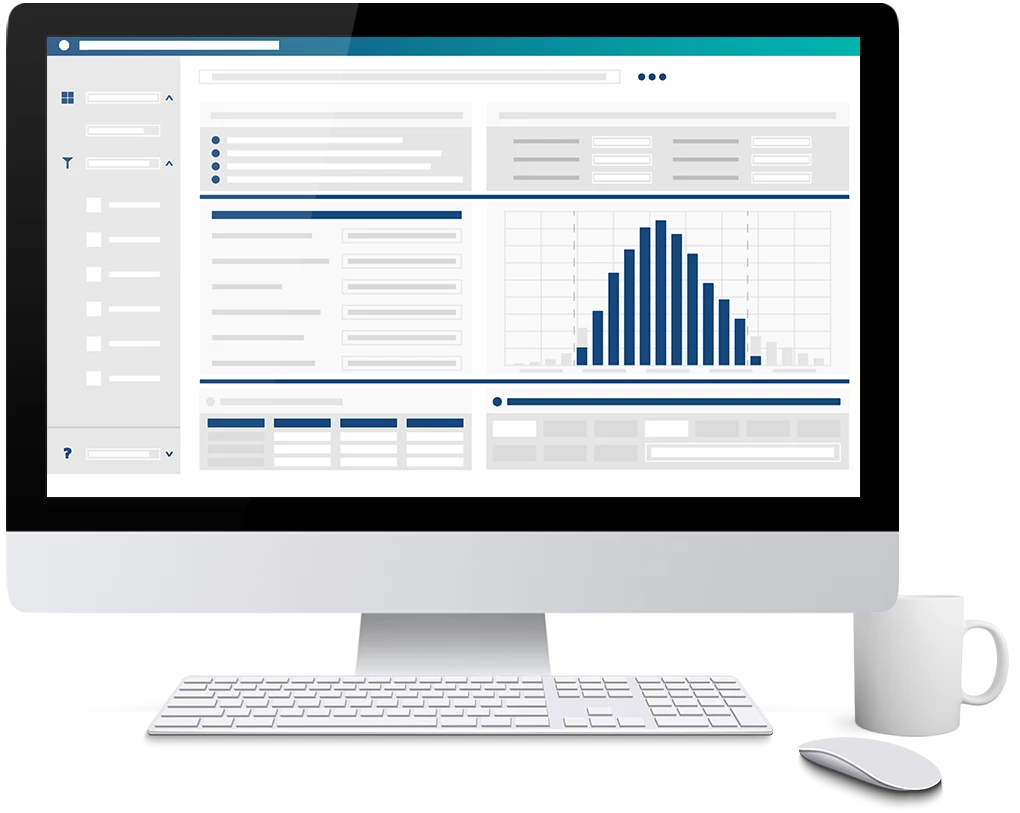BIC Process Design
Understand & Transform
Supercharge your business operations with the most intuitive AI-powered BPM software.
It seems that you come from a German speaking country. Here you can change the language
EnglishA Monte Carlo simulation is a mathematical technique used in probability theory and stochastics. It is used to solve problems numerically that are either impossible or extremely difficult to solve analytically. During the computational process, thousands of random experiments are performed with random input data. Each of these experiments generates different random variables based on probability functions. By applying mathematical distributions, a result with the highest possible accuracy is generated.

The basis of Monte Carlo is the law of large numbers. This law states that the more often a process is repeated under the same conditions, the more the relative distribution of random outcomes approaches the theoretical probability.
To illustrate this, let's take the simple case of a coin toss as an example: if you toss a coin 10 times only, it can easily happen that the actual ratio of heads to tails (relative frequency) deviates significantly from the expected 50/50 ratio . But if you repeat the coin toss 10,000 times, there's a very good chance that the relative frequency will approach that expected value - meaning that heads and tails occur about 5,000 times each.
As you can see from the coin toss, you can easily carry out such random experiments yourself. All you need is a coin, time, and most importantly, patience. However, in more complex situations, such as risk analysis, you’ll require computer calculations using Monte Carlo algorithms.

Monte Carlo simulations use algorithms to create a model of possible outcomes. This allows the relative distribution of the different scenarios to be simulated. For each random variable in this model, a probability distribution is created and then the results are recalculated thousands of times. Each of these calculations uses different random numbers within a certain range (between a maximum and a minimum value).
A major benefit of Monte Carlo simulation is that it provides an extremely accurate method of prediction. It is therefore particularly suitable for medium and long-term forecasts, with the accuracy of the results increasing with the number of entries. This makes it possible to project future results with greater precision and to simulate different scenarios. At the end, you’ll have a range of possible outcomes and know the relative probability with which each of these scenarios will occur.
The calculation of expected values using conventional methods (such as manual entry in a risk matrix) is highly prone to errors. These procedures focus exclusively on the isolated occurrence of risk and, therefore, do not provide any reliable explanations for potential business crises.
The Monte Carlo method, on the other hand, generates reliable results based on quantification by conducting a large number of random experiments. This allows the cumulative effects of risks to be presented realistically. In general, risks are evaluated by their probability of occurrence, their distribution, and their damage potential (e.g. via a 3-point estimate). As a result, you’ll get a comprehensive assessment of the overall risk situation through risk aggregation.
One outstanding feature of the Monte Carlo simulation is that it also takes into account the interdependencies between risks. This means that the results are not presented as individual values, but as a range of possible results (quantiles).
For some time now, we’ve observed that a purely qualitative risk assessment is no longer sufficient for many companies. The trend points clearly toward quantitative methods and simulation processes. This observation is also underscored by Gartner, who emphasizes the growing overall importance of quantitative assessments.
Since the beginning of 2021, there've also been new legal requirements in accordance with IDW PS 340. This auditing standard from the Institute of Public Auditors in Germany mainly deals with the statutory audit of the early risk detection system. The updated version of the standard now expressly stipulates the use of quantitative approaches and is mandatory for all listed companies. However, there's also a spillover effect on smaller companies.
The new version of the IDW PS 340 addresses various issues, including:

The emphasis on a company's obligations in relation to risk-bearing capacity and risk aggregation

The specification of the basic elements of an early risk detection system - based on the basic elements of risk management and compliance management systems

Clarifications on risk management and the consideration of "net risks" as basic elements of an early risk detection system
The points made about “risk-bearing capacity” and “risk aggregation” deserve special mention here. In practice, the aggregation of risks and their linkage to the risk-bearing capacity are only possible with quantitative approaches. Ultimately, the new statutory requirements force companies to take a quantitative look at their risks.
Quantification may seem complicated and challenging at first. The idea of having to spend days or weeks dealing with topics such as simulations, Monte Carlo analysis, probabilities, distributions and random numbers has a certain daunting effect.
But don't worry, running simulations is easier than it sounds! In BIC Enterprise Risk, we offer an integrated Monte Carlo tool to calculate and assess risks. With this tool, you can easily expand your risk management with quantitative methods and carry out a well-founded analysis of your overall risk situation at any time and at the touch of a button.
From the data obtained, you can then provide Management with relevant information to support decision-making and corporate planning. In doing so, you can strategically prepare for dangers and secure your company values in the best possible way. Additionally, you’re able to guarantee that your risk management meets all legal requirements at all times.
Download our whitepaper to get more exciting information about simulations and their diverse and concrete applications in BIC GRC.


In our webinar "Risk simulation with BIC Enterprise Risk: quantitative, audit-proof, software-supported!", our GRC experts dive into our extensive simulation options and show you directly in the tool how to master risk aggregation and risk simulation in a simple and intuitive way.
Discover on our website how to ensure professional and comprehensive coverage of all common standards in risk management with our user-friendly solution "BIC Enterprise Risk". With this ready-to-use solution, you can not only integrate simulation processes, but also optimize your risk management.

Learn how to use BIC Enterprise Risk to perform risk aggregation as effectively as possible.

BIC Enterprise Risk is our easy-to-use and intuitive standard solution covering all common standards.

GRC Solution Architect
Marcin is part of the Solution Development Team, specializing in creating advanced simulation solutions and delivering custom simulation projects. With over 8 years of experience in R programming, stochastic modeling, and data management, he's a trusted expert in simulation methodology. Marcin excels at designing innovative and sophisticated simulation use cases that integrate seamlessly with BIC GRC, helping to drive cutting-edge advancements in the field.